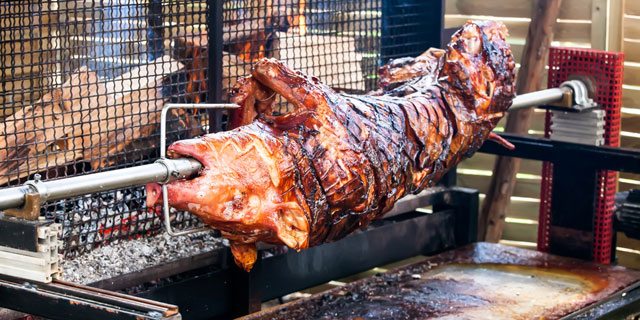At the centerpiece of every celebration during Puerto Rico’s famously extended holiday season: lechon, the island’s signature whole roasted pork. Groups of families and friends gather to hit their favorite lechoneras, restaurants dedicated to the tasty beast, during high pork season—starting on Thanksgiving and lasting through mid-January. Or, they simply roast a pig at home—just the action of cooking it is the perfect excuse for a giant party. We asked one of Puerto Rico’s best chefs, Kevin Roth, exactly how the home cook can turn their home into their own lechonera. Roth, who roasts big boys weekly at his popular restaurant La Estacion in Fajardo, also happens to be the champion of the Cattlemen’s BBQ Competition for best lechon. Here is his expert advice on a DIY pig-out.
RELATED: Guavate: Puerto Rico’s Pork Highway
What You Need
First things first, Roth says, “You need a pig, an oven of some sort, charcoal, and something to use as a spit to secure the pig to.” While a chef like Roth may source a fresh pig straight from a breeder, the average person can get a 60 pound pig via special order from a butcher or from stores such as Sam’s Club or Costco. “It should be packed, cleaned, and ready to go.” A simple zinc box or cinderblocks with a zinc top make up the traditional pig ovens of Puerto Rico. Unlike the Cuban caja China, the fire goes on the bottom of the oven, not the top.
“I prefer to cook from the bottom up for a few reasons,” Roth says. “With a caja China, there’s no peeking to see what’s going on. For me, watching it is a big part of the whole experience—the fire, the crackling noise, overseeing the movement of the pig—it’s like watching fireworks up until the grand finale.” Roth adds a few other key essentials: “Patience—you have to be willing to sit there for a long time to do it. You need help, it’s at least a two-person job, but the more people the better. And at least a six pack or two. Then you’re ready.”
Click on for the full prep!…
[pagebreak]
How to Prep
Concoct a marinade, slather it all over the pig, and let it infuse overnight in cold storage. Roth scores the pig’s skin before applying his marinade for best flavor penetration into the meat. “I use just a dry rub,” he explains. “Pretty much salt, garlic, oregano, and some other spices. Some people use just salt and pepper. Some use achiote spice. Some like to add sour orange. It completely depends on your taste.”
RECIPES: 10 Perfect Pork Recipes
Time to Roast
Get your fire started. “I always start the fire in one place inside the box, and once I get my fire going really good, I take that nice red charcoal and distribute it,” he explains. “The important thing is to have an even fire, equally distant from the pig.” The pig, tied to a spit, is placed on top. The box is covered with zinc. Then, go slow, watching and turning the pig, as well as moving the charcoal, as needed.
“Start on the ends with the charcoal,” Roth says, “And move it closer to the loin. But make sure it’s always even,” he cautions. Cooking time “depends on the size of the pig and on the heat, but generally, an 80-pound pig cooks in about 4 1/2 hours, with 15-20 minutes of toasting the skin, and then a solid half hour of resting.” Resting, Roth points out, is essential in order to retain the juices in the meat.
Click on for the finishing touches…
[pagebreak]How to Enjoy
Cut into the pig with a machete or a cleaver after resting. Many people like to slice off the skin first, referred to as the cuero, in order to maintain its crunchiness and not absorb too much of the fat. Then, Roth advises, take the head off the pig and quarter the body. “Separate your pernil (the shoulder) in the front and back and in between you have your loin and the costillas (ribs).”
RELATED: Traditional Puerto Rican Recipes You Need
The Final Ingredient
A large family and a giant group of friends to enjoy it all!
Feast on lechon at La Estacion every Sunday until April. Platter plus abundant sides, $22 per person.


![Making Mealtime Matter with La Familia: Easy Sofrito [Video]](https://thelatinkitchen.com/wp-content/uploads/2015/10/sofrito-shutterstock__0-500x383.jpg)
![Easy Latin Smoothies: Goji Berry Smoothie [Video]](https://thelatinkitchen.com/wp-content/uploads/2015/12/goji_berry-shutterstock_-500x383.jpg)
















![Fun and Fast Recipes: Fiesta Cabbage Salad [Video]](https://thelatinkitchen.com/wp-content/uploads/2015/11/fiesta_cabbage_slaw-shutterstock_-500x383.jpg)









